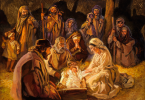
Theme: Trusting in God: way to eternal life.
Scripture readings: Jer 17:5-10; Ps. 1:1-4,6 ; Lk 16:19-31
Prophet Jeremiah is given an imagery on the trees by the Lord. The scholars say that it might have been influenced by the Psalm 1 which is today’s psalm in our liturgy. The imagery is used to show the contrast between the people who trust in the Lord and the people who trust in the material world. What was the difference between them? One is like a piece of dry shrub in the desert. It bears no fruit. It has no permanent source of nourishment. It has no companionship. The other tree is altogether different. It is transplanted. It is not planted because the verb is used here ‘שׁתל šātal’. So it is the same tree that is now transplanted to a place beside a stream. It sinks its roots deeply. It becomes richly fertile and productive. It is not afraid of the assaults of elements, particularly the heat. It is always remains fresh even in the dry, hot season. The imagery of the trees tells us; the trees which are transplanted at the stream are the people who trust in the Lord and the dry shrubs are the people who trust in the material world.
In the Gospel, Jesus gives a parable of rich man and Lazarus. The rich man is not named in the parable but it gives his description. He dressed in purple garment. It was a tradition of the rich according to the Romans. It also indicates that he was a high ranking Roman official and came from a royal family. He lived in a house with a gates. It meant to say that he had privacy and security. He was well secured. He also feasted sumptuously every day. This was dream for anyone who lived in Zion. The rich man appeared to be a tree that was planted near the stream but it was an illusion. The glamour of rich man’s life faded away in the second of the parable. Because it was not based on the eternal glory.
Whereas Lazarus, the poor man lived a life of dry shrub. Lazarus is the only person who is named in Jesus’ parable. The name helps to understand the life of a person. It came from Eleazar which means God helps. It was sad that there was no one to help Lazarus. He was crippled beggar. His body was covered with running sores. He was thrown before the rich man’s gate. He did not have anything to eat. The verb is used here to eat is χορτάζω chortazō. It indicates the feeding of animals rather than humans. The depth of Lazarus’ deprivation is expressed with the final detail: the dogs licked his sores as they passed by. Lazarus seemed to be a dry shrub from the imagery of Prophet Jeremiah.
The reversal took place in the second act of the parable where the rich man was reduced to nothingness. He became the dry shrub and Lazarus who appeared to be dry shrub now became the tree that was transplanted at the stream. The only thing made a difference was their trust in the Lord. The rich man totally relied on the riches of the world whereas Lazarus trusted in the riches of God. Lazarus who was speechless in the parable has a voice in heaven. Abraham spoke on his behalf. The result is seen Lazarus in the bosom of Abraham. According to Jewish legends of the death of mother and her seven sons (2 Maccabees 7), the bosom of Abraham was regarded as the highest bliss.
How do we live in this world? Do we trust in the riches of this material world or do we trust in God? Let this season of Lent help us to realize that the glitters of this material world are illusion. They pass away. What helps man to attain bosom of Abraham is the complete trust in the Lord, not in the material world.
Fr. Alex D’Mello







